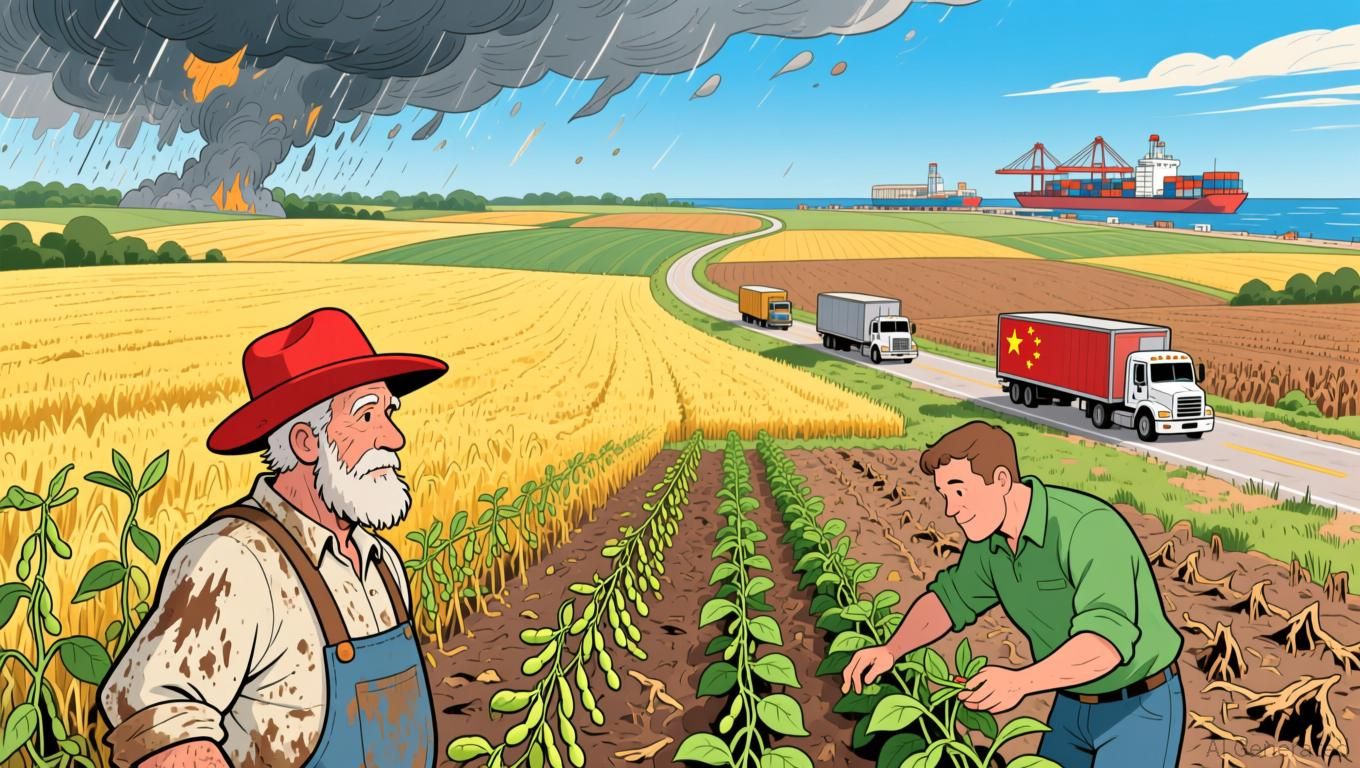China’s Influence on Soybean Trade and a Failing System Push U.S. Farmers into Turmoil
- U.S. rural farmers face crisis as China's reduced soybean purchases and trade disputes drive plummeting prices and high debt. - Federal aid programs provide short-term relief but fail to address systemic issues like inflated land prices and structural profitability gaps. - Trump's trade policy adjustments offer mixed signals, temporarily easing tariffs on imports while China maintains residual soybean duties as geopolitical leverage. - Record farm debt and grocery insecurity highlight a K-shaped recovery
The agricultural economy in rural America is experiencing an uneven recovery, with government assistance reaching emergency levels as ongoing trade conflicts and deep-rooted challenges widen the gap between struggling farmers and more stable agricultural sectors. The situation has worsened due to China's ongoing hesitation to resume significant U.S. soybean imports, leaving farmers in the Midwest facing falling prices, rising production expenses, and unpredictable trade regulations. Meanwhile,
The trade standoff over soybeans between the U.S. and China has become a central issue in the economic hardships facing rural communities. Since October 2025, China has committed to buying 12 million metric tons of U.S. soybeans—less than half of the 26.8 million metric tons it imported in 2024. This gap has left Wisconsin's soybean farmers—whose industry is worth $1.3 billion a year—dealing with losses as global prices drop. "The unpredictability of trade policy has added more pressure on farmers who are already struggling to make future plans," stated Paul Mitchell, an agricultural economics professor at the University of Wisconsin-Madison

The federal response has included emergency support, such as $30 billion in relief for Emergency Commodity Assistance and Supplemental Disaster Relief programs. Still, critics argue these efforts fall short, often driving up land values instead of improving farm profitability. "Farmers are stuck in a dysfunctional system," said Joe Maxwell from Action Farm Fund, a farmer advocacy group. "We keep spending on temporary solutions while the core issues in agriculture remain unaddressed"
Recent changes in trade policy under President Donald Trump have sent mixed messages. On November 13, Trump issued an executive order that exempts major agricultural imports—such as Indian spices, coffee, and tropical fruits—from a 50% tariff increase, citing concerns over rising domestic prices. This move, part of broader trade talks, is intended to lower food costs for Americans and reduce pressure on importers. In a separate agreement, China has paused retaliatory tariffs on U.S. soybeans in return for reduced U.S. tariffs, though a 13% duty still applies
The pronounced split in the farm economy underscores the vulnerability of rural livelihoods. While large agribusinesses and major producers are able to adjust to changing trade conditions, smaller farms are facing severe risks. The latest figures from the Federal Reserve indicate that farm debt has hit unprecedented levels, with
Disclaimer: The content of this article solely reflects the author's opinion and does not represent the platform in any capacity. This article is not intended to serve as a reference for making investment decisions.
You may also like
APAC Leads Global AI Growth with Emphasis on Human-Focused Approaches
- APAC leads global AI adoption with 26% of firms investing $400k-$500k in generative AI, driven by CEO-led strategies (33% APAC vs 18% North America). - 91% APAC employees receive AI training, supporting rapid deployment as energy management markets grow from $56B to $219B by 2034 via AI analytics and blockchain. - Pegasystems and Ambarella showcase AI integration in enterprise automation and computer vision, while SoundHound AI leverages $269M liquidity for strategic acquisitions. - Challenges persist fo

Republican Party Splits and Inflation Issues Created Internally Complicate Trump’s Plans for a Second Term
- Trump's second-term agenda faces GOP internal divisions and affordability crises as inflation and tariff policies strain public support. - Republican lawmakers like Rep. Massie challenge Trump's Epstein file stance, exposing party fractures despite official "America First" alignment. - Tariff rollbacks on staples address self-inflicted inflation but fail to resolve core affordability concerns undermining Trump's economic legacy. - Constitutional term limits and waning influence in Trump's "lame duck" per
Dogecoin News Today: Institutional Altcoin ETFs Resist Crypto Market Downturn
- Grayscale and VanEck launch Dogecoin/Solana ETFs as crypto markets decline, defying broader outflows. - U.S. spot Bitcoin ETFs see $870M outflows; Ethereum ETFs lose $259.7M amid third-week withdrawal streak. - Institutional altcoin ETFs gain traction with $550M+ assets, signaling growing crypto legitimacy in portfolios. - Ethereum's 3.6M token treasury and Fusaka upgrade optimism contrast with 4% ETF outflows of AUM. - Persistent retail caution contrasts with institutional adoption, as crypto's traditio

Bitcoin News Update: Blockchain.com’s Co-CEOs Steer Through Crypto Market Fluctuations as Company Relocates Headquarters to Texas
- Blockchain.com appoints Lane Kasselman as co-CEO alongside Peter Smith, adopting a dual leadership model to enhance operational efficiency during transition. - The firm relocates its U.S. headquarters to Dallas, Texas, leveraging the state's tax incentives, regulatory flexibility, and proximity to the Texas Stock Exchange. - This move aligns with broader corporate trends in Texas, as companies like Coinbase and McKesson shift operations to capitalize on business-friendly policies and innovation hubs. - T
